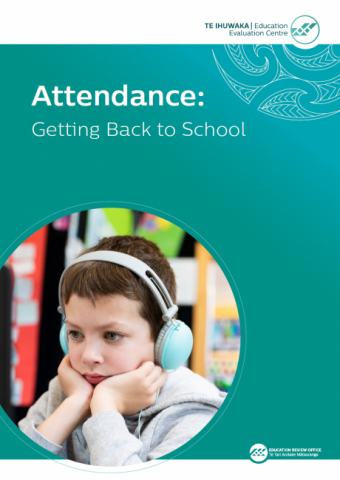Summary
Regular attendance at school is critical to achievement and Aotearoa New Zealand’s future. Our attendance is lower than other comparable countries and attendance levels have been falling since 2015. This drop was evident before the Covid-19 pandemic, and attendance continues to fall.
While there are a range of factors that impact on attendance, our research shows that some are more important than others. This report sets out the drivers of attendance that have the biggest impact on whether learners go to school regularly. These include parents’ attitudes, learners’ attitudes, and how learners experience school.
Whole article:
Attendance: Getting Back to SchoolIntroduction
Going to school is critical for our children’s futures. The evidence is clear that every day of school matters – missing school leads to lower achievement. In Aotearoa New Zealand, learners are expected to attend school every day the school is open, yet many don’t. We have lower attendance than other countries and, alarmingly, attendance is falling.
Last year we published a report on why learners miss school – Missing Out: Why Aren’t Our Children Going to School?. This report sets out the biggest drivers of school attendance and what families and schools can do to help.
What is attendance?
Attendance is when learners are at school and in the class they are supposed to be in. If learners miss a week or more of school in a term they have ‘non-regular attendance’. Learners who miss a week each term will have missed out on a year of schooling by the time they are 16.
What has happened to attendance in Aotearoa New Zealand?
Aotearoa New Zealand has consistently had lower attendance than other countries. The Covid-19 pandemic has further reduced attendance.
Figure 1: International comparison of regular attendance
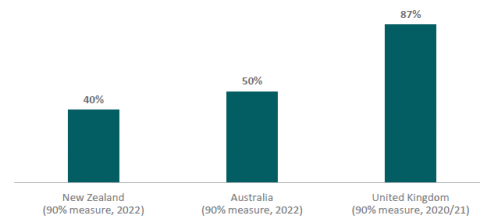
Figure one is a graph comparing the regular attendance rates for New Zealand, Australia and the United Kingdom. Regular attendance is defined as attending more than ninety percent of the time.
The regular attendance rate for New Zealand was forty percent in 2022.
The rate for Australia was fifty percent in 2022.
The rate for United Kingdom was eighty seven percent in 2022/2021.
Source: Ministry of Education; Australian Curriculum, Assessment and Reporting Authority.
The rate of regular attendance continues to fall. Between 2015 and 2019, there was a 12 percentage point drop in the rate of regular attendance. By 2022, the rate of regular attendance reached 40 percent, a further 18 percentage point fall from 2019. In 2022, attendance was impacted by high Covid-‑19 case numbers but the longer-term trend is clear. All NZ figures show the percentage of learners who attended school more than 90 percent of the time in Term 2 of the respective years.
Declining attendance is seen across all school types and for all ethnicities. The drop has been steepest in low decile schools, and for Māori and Pacific learners.
Figure 2: Percentage of learners regularly attending in 2015, 2019, and 2022
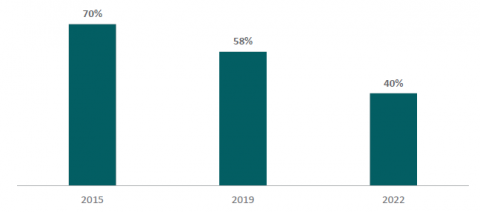
Figure two is a graph showing the percentage of learners who regularly attend school in New Zealand in 2015, 2019 and 2022.
In 2015, seventy percent of learners were attending regularly.
In 2019, fifty eight percent of learners were attending regularly.
In 2022, forty percent of learners were attending regularly.
Source: Ministry of Education.
Why are learners missing school?
We know that learners’ and parents’ attitudes and how learners experience school impacts on attendance. This report sets out further analysis to identify the most important individual drivers (we conducted a logistic regression and all reported drivers are significant at p>0.05). These are the drivers that have the biggest effect on whether a learner attends school regularly or not.
For parents the most important attitudes are:
- how comfortable they are with their child missing school
- how likely they are to keep their child home:
- if their child is being bullied
- if their child is unable to participate in school activities
- for a family or special event
- for mental health reasons.
For learners the most important attitudes are:
- if they think going to school every day is important
- if they see school as helpful for their future
What happens in school matters as well. For learners the most important school-based factors are:
- how hard they find their schoolwork
- if they can participate in activities
- if they like or don’t like the people in their class
- if they like or don’t like their teacher(s)
- if they like or are interested in what they are being taught.
Parent attitudes matter
We know that four in 10 parents (41 percent) are comfortable with their child missing a week or more of school a term. This really matters for attendance. Parents who are comfortable with their child missing a week or more of school per term are more than twice as likely to have a child who doesn’t regularly attend school (61 percent), compared to those parents who are not comfortable with their child missing a week or more of school (27 percent). Regularly attending is missing less than a week of school a term, not regularly attending is missing a week or more of school a term.
Figure 3: Learner attendance by parent comfort levels with child missing school
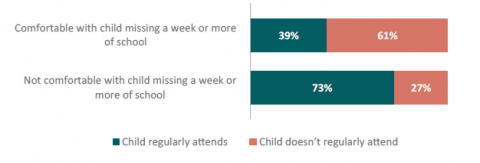
Figure three is a graph showing the percentage of children regularly attending and not regularly attending school by parent comfort levels with their child missing school.
For parents who are comfortable with their child missing a week or more of school, thirty nine percent had children who regularly attend school, while sixty one percent had children who didn’t regularly attend school.
For parents who weren’t comfortable with their child missing a week or more of school, seventy three percent had children who regularly attend school, while twenty seven percent had children who didn’t regularly attend school.
Why parents let their children miss school also matters. Letting children miss school for a particular reason can change their attitudes to attendance and increase the chance of irregular attendance.
Parents who would keep their child out of school because their child was being bullied are 23 percentage points more likely to have a child that doesn’t attend school regularly (51 percent compared to 28 percent).
Figure 4: Learner attendance by whether a parent would keep their child out of school if their child is being bullied
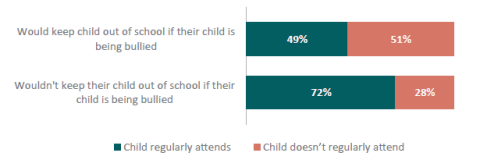
Figure four is a graph showing the percentage of children regularly attending and not regularly attending school by whether a parent would or wouldn’t keep their child out of school if their child was being bullied.
For parents who would keep their child out of out of school if they were being bullied, forty nine percent had children who regularly attend school, while fifty one percent had children who didn’t regularly attend.
For parents who wouldn’t keep their child out of out of school if they were being bullied, seventy two percent had children who regularly attend school, while twenty eight percent had children who didn’t regularly attend.
Parents who would keep their child out of school because their child isn’t able to participate in certain activities are 22 percentage points more likely to have a child that doesn’t attend school regularly (57 percent compared to 35 percent).
Parents who would keep their child out of school because there is a family/whānau/special event on are 21 percentage points more likely to have a child that doesn’t attend school regularly (46 percent compared to 25 percent).
Parents who would keep their child out of school for mental health challenges are 11 percentage points more likely to have a child that doesn’t attend school regularly (49 percent compared to 38 percent).
Learners’ attitudes matter
For learners, we found that the biggest driver is how important they think going to school every day is.
Learners who think going to school every day is important are 23 percentage points more likely to attend regularly than those who don’t (60 percent compared to 37 percent).
Figure 5: Learner attendance by whether learners think going to school every day is important

Figure five is a graph showing the percentage of learners regularly attending and not regularly attending school by whether they think going to school every day is important.
For learners who think going to school every day is important, sixty percent regularly attend school while forty percent don’t regularly attend school.
For learners who don’t think going to school every day is important, thirty seven percent regularly attend school while sixty three percent don’t regularly attend school.
For secondary learners, seeing school as important to their future really matters. Those who think school is important for their future are 26 percentage points more likely to attend regularly (52 percent compared to 26 percent).
School-based factors matter
What schools do and how learners feel about it also has an impact. ERO has found, in its work with schools across the country, that schools who perform well on all other aspects have higher attendance levels.
For learners in primary schools, the biggest driver of wanting to miss school is if they think their schoolwork is too hard. Primary learners who want to miss school because their schoolwork is too hard are 11 percentage points less likely to attend regularly than other learners (48 percent compared to 59 percent).
For learners in secondary schools the most important school-based barriers were:
- not being able to participate in activities
- not liking the people in their class
- not liking their teacher(s)
- not liking or being interested in what they are taught.
Not being able to participate in activities – Secondary learners who want to miss school because they are unable to participate in some activities are 33 percentage points less likely to attend regularly (14 percent compared to 47 percent).
Figure 6: Learner attendance by whether learners want to miss school due to not being able to participate in certain activities

Figure six is a graph showing the percentage of learners regularly attending and not regularly attending school by whether they want to miss school due to not being able to participate in certain activities.
For learners who want to miss school because they can’t participate in some school activities, fourteen percent regularly attend school, while eighty six percent don’t regularly attend school.
For learners who didn’t indicate they want to miss school because they can’t participate in some school activities, forty seven percent regularly attend school while fifty three percent don’t regularly attend school.
Not liking the people in their class – Secondary learners who want to miss school because they don’t like the people in their class are 20 percentage points less likely to attend regularly (30 percent compared to 50 percent).
Not liking their teacher(s) -Secondary learners who want to miss school because they don’t like at least one of their teachers are 19 percentage points less likely to attend regularly (32 percent compared to 51 percent)
Being interested in what they are taught – Secondary learners who wanted to go to school because they are interested in what they are taught they are 18 percentage points more likely to attend regularly (57 percent compared to 39 percent).
How to improve attendance
Attendance is complicated, and parent and learner attitudes and circumstances matter. Not all of these issues are within a school’s control, but schools have a crucial impact. Schools can act to improve attendance.
School responses need to differ according to the level of non-attendance. Schools need strategies that help all children attend regularly, early identification and action for those learners who are starting to not attend, and more intensive targeted interventions for those who are chronic non-attenders.
This report looks at how schools can help these students who do attend but not regularly enough. Given what we know about what drives attendance along with international evidence on what is effective, the three key actions schools can take are:
- increasing parents’ awareness and expectations
- making learning engaging and school a great place to be
- identifying and tackling specific barriers.
1. Increasing parents’ awareness and expectations
- Make sure parents know that attendance is important and set expectations accordingly.
- Make sure parents know how much their child is attending.
- Deliver these messages early and often.
Parental attitudes are really important for learner attendance. Parents who are comfortable with their child missing a week or more of school were more than twice as likely to have a child who doesn’t regularly attend school.
International evidence[1][2] shows that parents may not recognise the importance of regular school attendance and the consequences of their child not attending. Parents can also underestimate the amount of school their children are missing and, as learners become more independent at secondary school, parents may be unaware of attendance patterns. Schools can help to address this by making the ongoing impact of non-attendance on students’ learning vivid for parents. Attendance habits that begin at primary school follow through into later education, so it is important to deliver these messages early and often. Schools should also immediately contact parents when learners are absent, and escalate early in the face of persistent non-attendance.
ERO has seen schools demonstrating promising practices in this area:
- using achievement data linked with attendance data to show the impact of attendance on achievement and sharing this with family, learners, and teachers
- doing a breakdown on the impact of attendance to really highlight how attendance and achievement are connected
- including this type of information in newsletters or regular updates to ensure the best reach possible
- proactively sharing attendance information and patterns so that parents have a good sense of how much school their children are missing.
2. Making learning engaging and school a great place to be
- Create a welcoming environment.
- Promote positive relationships between teachers and learners.
- Get learners interested in what they are learning.
Not being interested in what is taught is a big driver of non-attendance, along with not liking at least one teacher and not liking the people in class.
The international evidence is clear that creating a great, welcoming environment at school promotes attendance. Evidence suggests promoting positive relationships between teachers and learners and promoting connectedness and belonging are two key ways to improve attendance. This can go alongside implementing an anti-bullying plan and ensuring cultural safety.
Engagement with school is also important. Learners who are interested in schoolwork and activities at school are more likely to attend. In addition, having strong motivation and goals around achievement and positive beliefs about their own academic abilities promotes attendance.
To make learning more engaging and make school a great place to be we recommend the following actions.
- Understand learners’ interests and what they find engaging or disengaging at school.
- Understand how learners find the school environment, listen to learners’ perspectives, and identify areas of concern early.
- Review the way in which teaching and learning is organised, drawing on learner perspectives.
- Help learners to see how subjects are relevant and valuable to them, and that they are capable of achieving in those subjects
- Take early action when learners are disengaging from learning and provide support to re-engage and catch up.
- Use proven tools to tackle bullying, racism, and discrimination.
- Provide access to targeted mental health support for those who need it.
ERO has seen schools demonstrating promising practices in this area, such as:
- having days at school, such as ‘Ice block Friday’, in primary schools or community sports days in secondary schools, that encourage school attendance and make school a fun place to be
- hosting special events such as grandparents’ day (in a primary school context) to increase learners’ feeling of connection between home and school and provide variety to their days
- supporting the social side of school through vertical form groups (in a secondary school context) to build relationships between year levels
- ensuring that each learner has an adult at school who will notice and care if they are there or not.
3. Identifying and tackling specific barriers
- Find out exactly what is making attendance more difficult.
- Develop responsive strategies for specific barriers.
- Work together with families/whānau.
We know there are a wide range of reasons that learners miss school. Many of these are due to learners or their parents facing barriers to attending. Evidence shows that broad approaches aren’t sufficient to improve attendance for learners with more complex barriers to attendance. Context and specific needs of learners matter.
Responses could include discussions between school staff and parents to find out why a learner might not be attending and to uncover possible ways to solve these reasons. This requires both parents and school staff to develop a plan together to improve attendance. Schools and families need to identify any support the learner and family need. Depending on what families need, the response may require multiple services, which the school can help to co-ordinate. Some of the three most common elements of successful strategies are:
- individualised training in personal and social capabilities
- family support
- offering some incentives for attendance.
ERO has seen schools demonstrating promising practices in this area, such as:
- monitoring at-risk learners closely by having their initials on a whiteboard in the principal’s office so they are always top of mind for the principal to monitor their attendance
- organising home visits or hui between school staff and parents to discuss learners with low attendance and come up with targeted support and solutions
- coming up with personalised plans alongside parents for learners with low attendance which sometimes involves accessing community aid programs and any agencies that are available to provide support to the family and learner
- providing resources for teachers and parents to help them have discussions with learners about why the learner didn’t want to attend. This can open up and destigmatise the conversation about attendance with learners so school staff and parents can figure out the underlying reasons. The resource has contact details for different people in the school who can help support learners with the range of reasons for not attending.
Conclusion
Regular attendance at school is critical to achievement and Aotearoa New Zealand’s future. We need to act now to change the trend of declining attendance. While there are a range of factors that impact on attendance, our research shows that some are more important than others. Similarly, different factors are more important for different learners in different contexts. International evidence and our own research highlights the importance of understanding specific barriers and putting targeted responses in place to address these.
Links for further information and ideas for teachers
Te Mahau – All in for learning | Kia kotahi te ū ki te ako
He Whakaaro: School attendance and student wellbeing
He Whakaaro: What is the relationship between attendance and attainment?
Appendix 1: What ERO did
Data collected for this report included:
- surveys of 2641 Year 4 to 13 learners across Aotearoa New Zealand
- surveys of 1133 parents of school-aged children across Aotearoa New Zealand
- six whānau/parent focus groups (37 parents)
- ten learner focus groups (80 learners)
- interviews and focus groups with a total of 41 school leaders and teachers from 33 schools across Aotearoa New Zealand.
- ERO’s engagement with schools through Evaluation Partners
- a scan of international literature on attendance
ERO has also drawn on data collected and reported by the Ministry of Education.
[1] https://d2tic4wvo1iusb.cloudfront.net/documents/pages/Attendance-REA-report.pdf?v=1674658557
[2] https://education.nsw.gov.au/content/dam/main-education/about-us/educational-data/cese/2022-understanding-attendance.pdf
